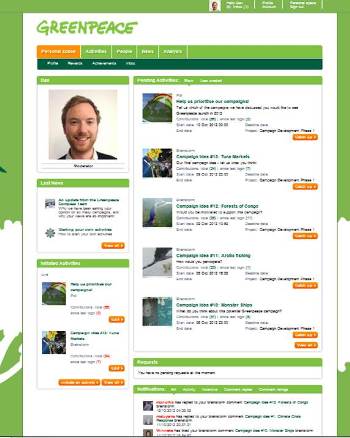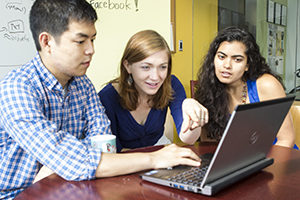There were some new voices at this year’s annual Greenpeace planning meeting, where a global network of leaders, scientists and activists convened to vote on top priorities for the following year.
Using an innovative tool called Greenpeace Compass, Greenpeace was able to conduct market research with 400 of its community supporters, sharing this feedback and ideas during the planning meeting.
“The purpose of the project was to give supporters a seat at the table at the biggest planning meeting we have,” explains Martin Lloyd, Greenpeace International’s marketing and communications manager, who worked on Greenpeace Compass.
“The feedback from this community was delivered to the meeting and met with great enthusiasm, and that’s the first step to operationalizing it.”
The new tool is the latest move by Greenpeace to find ways to engage its supporters more deeply in the organization.

Greenpeace Compass homepage
Starting two months ago, Greenpeace Compass invited people who receive Greenpeace e-mails, volunteers and donors to join Greenpeace Compass and help plan the organization’s future.
Of the 1,200 people who signed up, 400 people were active participants taking part in the online community through activities like brainstorms, debates and live online workshops.
Participants were asked to spend at least 15 minutes per week on the site, and Martin estimates the collective time spent on Greenpeace Compass to be 700 hours.
“You start to get idea that there is a lot of untapped potential there,” he says, adding Greenpeace was impressed at the engagement level.
“We’ve had people designing posters for us, we’ve had people writing scripts for commercials they think would work for a campaign, all sorts of things they’re willing to do and suggest, it’s great.”
(Click here to see a user-made video uploaded to Greenpeace Compass)
The online community was also an opportunity for Greenpeace to explore future campaigns with supporters and learn if they’d be interested in getting involved.
Martin says there is an enormous benefit to interacting with people in such a direct fashion, providing Greenpeace with valuable insights about current and future campaigns. Greenpeace is sharing these takeaways with campaign staff.
“It’s been one of the most well received pieces of market research we’ve done here. There seems to be a lot of enthusiasm inside the organization for understanding what these people are saying and what it is their suggesting,” says Martin.
With Greenpeace Compass including participants from 116 countries, the compass was able to glean broader observations related to Greenpeace and its mission.
For example, Greenpeace learned its community is quick to see the connectedness of environmental issues. While at times Greenpeace has grappled with whether to lump logging in the Congo with other logging issues happening across the globe, results from its survey show people see the big picture and want global solutions.
The same goes for climate change, where people are concerned about impacts beyond their back yard, including the Arctic’s rapidly melting ice.
In Asia, where Greenpeace is still relatively new, Greenpeace Compass found there is an interest organizing and political advocacy, a surprising finding considering political activism isn’t prominent in most Asian cultures, says Martin.
While Greenpeace’s community is engaged and educated on the issues, supporters don’t know a lot about Greenpeace, the compass found. According to Martin, there is room for Greenpeace to do a better job at communicating its social role, and how it operates as an organization.
What’s Next for Greenpeace Compass
Greenpeace Compass will continue until the end of year, and possibly longer.
The second stage of the project will allow Greenpeace Compass to dig deeper into campaigns and issues, for example asking its community to help shape campaign messaging.
In the future, Martin says there is the possibility to pilot Greenpeace Compass in specific countries and other languages, as well as use the tool for ongoing campaign planning and rapid response to critical events.
Greenpeace Compass tried the latter approach when Hurricane Sandy was barrelling towards New York. Posting an image of a demonstration from 350.org, Greenpeace Compass asked its supporters what they thought of the protest.
“Rather than just putting stuff out in the media and waiting to see what comes back much later, you can have an immediate sense of what matters to our supporters and what they think we could be doing,” says Martin.
“For those of us, and this includes me working in communications, it’s always really valuable to spend some time talking with the audience, this is sort of the ultimate audience.”
To learn more about Greenpeace Compass, click here.
Stay Connected: @mrlloydgp
Related Stories:
Nonprofits collect data but do they use it? NTEN and Idealware report looks at the state of nonprofit data
Greenpeace USA empowers students to drive campus campaigns
Do you have an innovation in mobilisation and people-powered campaigns? Share it with Mob Lab by contacting moblab@greenpeace.org.
Categories:
testing, learning and iteration


